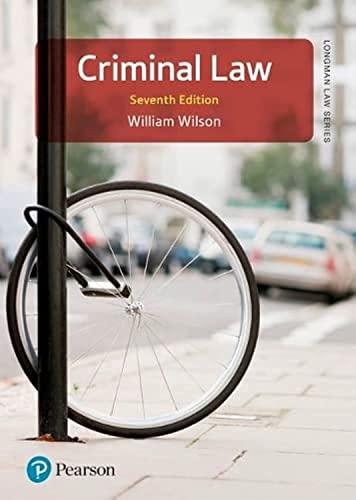Question
7. Omitting to do something is generally not a criminal offence unless the person has a legal obligation to do something, and then fails to
7. Omitting to do something is generally not a criminal offence unless the person has a legal obligation to do something, and then fails to do it. Please list one Criminal Code provision, one Ontario statute and one Qubec statute that create legal obligations that can lead to criminal or quasi-criminal liability.
8. A parent has a legal obligation to provide the necessaries of life to a child. Does an adult child have any legal obligation to provide the necessaries of life to a vulnerable parent? Answer yes or no, and name the case that supports your position. What section of theCriminal Codecould create such a duty? 12. Can a person be a party to an offence simply by silently being present at the scene of the crime? Please elaborate on your answer, citing at least one relevant case.
13. When two or more people agree to commit a crime together, and the crime is committed, they will each be charged as a party to the crime. One of them might take the position that they had changed their mind and abandoned the plan. Please discuss the defence of abandonment and explain the circumstances in which it applies. In answering this question, please make sure (a) to set out the prerequisites for a successful defence of abandonment, (b) to name the 2013 Supreme Court of Canada case that explains these requirements, and (c) to explain how this case changed the law.
14. R. v. Beatty(2008, SCC) sets out theactus reusand themens reafor negligence based offences, in this case Dangerous Driving. Please explain the test. When this test is properly applied, does momentary inattention amount to "dangerous driving"?
17. What are the 6 ways that a person can be a party to an offence?
20. Compare absolute liability and strict liability offences in terms of (a) what they have in common and (b) how they are different, in terms of what the Crown must prove and what defences are available. Refer to at least one decision of the Supreme Court of Canada.
Step by Step Solution
There are 3 Steps involved in it
Step: 1

Get Instant Access to Expert-Tailored Solutions
See step-by-step solutions with expert insights and AI powered tools for academic success
Step: 2

Step: 3

Ace Your Homework with AI
Get the answers you need in no time with our AI-driven, step-by-step assistance
Get Started


